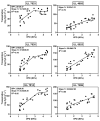High-Temperature and Drought Stress Effects on Growth, Yield and Nutritional Quality with Transpiration Response to Vapor Pressure Deficit in Lentil
- PMID: 35009098
- PMCID: PMC8747359
- DOI: 10.3390/plants11010095
High-Temperature and Drought Stress Effects on Growth, Yield and Nutritional Quality with Transpiration Response to Vapor Pressure Deficit in Lentil
Abstract
High temperature and water deficit are among the major limitations reducing lentil (Lens culinaris Medik.) yield in many growing regions. In addition, increasing atmospheric vapor pressure deficit (VPD) due to global warming causes a severe challenge by influencing the water balance of the plants, thus also affecting growth and yield. In the present study, we evaluated 20 lentil genotypes under field conditions and controlled environments with the following objectives: (i) to investigate the impact of temperature stress and combined temperature-drought stress on traits related to phenology, grain yield, nutritional quality, and canopy temperature under field conditions, and (ii) to examine the genotypic variability for limited transpiration (TRlim) trait in response to increased VPD under controlled conditions. The field experiment results revealed that high-temperature stress significantly affected all parameters compared to normal conditions. The protein content ranged from 23.4 to 31.9%, while the range of grain zinc and iron content varied from 33.1 to 64.4 and 62.3 to 99.3 mg kg-1, respectively, under normal conditions. The grain protein content, zinc and iron decreased significantly by 15, 14 and 15% under high-temperature stress, respectively. However, the impact was more severe under combined temperature-drought stress with a reduction of 53% in protein content, 18% in zinc and 20% in iron. Grain yield declined significantly by 43% in temperature stress and by 49% in the combined temperature-drought stress. The results from the controlled conditions showed a wide variation in TR among studied lentil genotypes. Nine genotypes displayed TRlim at 2.76 to 3.51 kPa, with the genotypes ILL 7833 and ILL 7835 exhibiting the lowest breakpoint. Genotypes with low breakpoints had the ability to conserve water, allowing it to be used at later stages for increased yield. Our results identified promising genotypes including ILL 7835, ILL 7814 and ILL 4605 (Bakria) that could be of great interest in breeding for high yields, protein and micronutrient contents under high-temperature and drought stress. In addition, it was found that the TRlim trait has the potential to select for increased lentil yields under field water-deficit environments.
Keywords: biofortification; canopy temperature; crude protein; drought stress; grain yield; lentil; limited transpiration trait; temperature stress; vapor pressure deficit; zinc and iron.
Conflict of interest statement
The authors declare no conflict of interest.
Figures





Similar articles
-
Limited-transpiration trait in response to high vapor pressure deficit from wild to cultivated species: study of the Lens genus.J Exp Bot. 2023 Sep 2;74(16):4875-4887. doi: 10.1093/jxb/erad264. J Exp Bot. 2023. PMID: 37422910
-
Heat and Drought Stress Impact on Phenology, Grain Yield, and Nutritional Quality of Lentil (Lens culinaris Medikus).Front Nutr. 2020 Nov 23;7:596307. doi: 10.3389/fnut.2020.596307. eCollection 2020. Front Nutr. 2020. PMID: 33330596 Free PMC article.
-
Understanding and Exploiting Transpiration Response to Vapor Pressure Deficit for Water Limited Environments.Front Plant Sci. 2022 May 10;13:893994. doi: 10.3389/fpls.2022.893994. eCollection 2022. Front Plant Sci. 2022. PMID: 35620701 Free PMC article.
-
Limited-transpiration response to high vapor pressure deficit in crop species.Plant Sci. 2017 Jul;260:109-118. doi: 10.1016/j.plantsci.2017.04.007. Epub 2017 Apr 24. Plant Sci. 2017. PMID: 28554468 Review.
-
Lentil adaptation to drought stress: response, tolerance, and breeding approaches.Front Plant Sci. 2024 Aug 20;15:1403922. doi: 10.3389/fpls.2024.1403922. eCollection 2024. Front Plant Sci. 2024. PMID: 39228838 Free PMC article. Review.
Cited by
-
Enhancing cold and drought tolerance in cotton: a protective role of SikCOR413PM1.BMC Plant Biol. 2023 Nov 18;23(1):577. doi: 10.1186/s12870-023-04572-6. BMC Plant Biol. 2023. PMID: 37978345 Free PMC article.
-
Effect of High Temperature Stress During the Reproductive Stage on Grain Yield and Nutritional Quality of Lentil (Lens culinaris Medikus).Front Nutr. 2022 Apr 15;9:857469. doi: 10.3389/fnut.2022.857469. eCollection 2022. Front Nutr. 2022. PMID: 35495922 Free PMC article.
-
Investigating the influence of elevated temperature on nutritional and yield characteristics of mung bean (Vigna radiata L.) genotypes during seed filling in a controlled environment.Front Plant Sci. 2023 Sep 21;14:1233954. doi: 10.3389/fpls.2023.1233954. eCollection 2023. Front Plant Sci. 2023. PMID: 37810386 Free PMC article.
-
Impact of Terminal Heat and Combined Heat-Drought Stress on Plant Growth, Yield, Grain Size, and Nutritional Quality in Chickpea (Cicer arietinum L.).Plants (Basel). 2023 Oct 30;12(21):3726. doi: 10.3390/plants12213726. Plants (Basel). 2023. PMID: 37960082 Free PMC article.
-
A Review of Data for Compound Drought and Heatwave Stress Impacts on Crops: Current Progress, Knowledge Gaps, and Future Pathways.Plants (Basel). 2025 Jul 13;14(14):2158. doi: 10.3390/plants14142158. Plants (Basel). 2025. PMID: 40733395 Free PMC article. Review.
References
-
- Sarker A., Kumar S. Lentils in production and food systems in West Asia and Africa. Grain Legum. 2011;57:56–58.
-
- Erskine W., Sarker A., Kumar S. Crops that feed the world Investing in lentil improvement toward a food secure world 3. Food Secur. 2011;3:127–139. doi: 10.1007/s12571-011-0124-5. - DOI
-
- Reda A. Lentil (Lens Culinaris Medikus) Current Status and Future Prospect of Production in Ethiopia. Adv. Plants Agric. Res. 2015;2:00040. doi: 10.15406/apar.2015.02.00040. - DOI
-
- Bouis H., Low J., McEwan M., Tanumihardjo S. Biofortification: Evidence and Lessons Learned Linking Agriculture and Nutrition. FAO; Rome, Italy: WHO; Geneva, Switzerland: 2013.
Grants and funding
LinkOut - more resources
Full Text Sources

